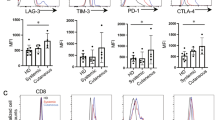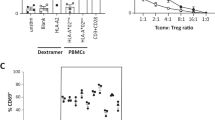Abstract
A human skin allograft injury model in immunodeficient mice, engrafted with human peripheral blood mononuolear cells from a different donor, has been used to test whether reagents that block human T cell CD2 Interactions with its principal ligand, LFA-3 (CD58), can inhibit immune reactions in vivo. In this model, human skin grafts show a reproducible pattern of progressive human T-cell infiltration and human graft microvascular injury that resembles human first-set skin graft rejection. Murine Mab to human LFA-3 or human LFA-3-lgG1 fusion protein, but not isotype-matched control antibodies, each markedly protected skin grafts from leukocyte infiltration and injury. These data provide the first evidence that LFA-3 functions in vivo and establish the ability of this new model to test human-specific immune modulators.
This is a preview of subscription content, access via your institution
Access options
Subscribe to this journal
Receive 12 print issues and online access
$209.00 per year
only $17.42 per issue
Buy this article
- Purchase on Springer Link
- Instant access to full article PDF
Prices may be subject to local taxes which are calculated during checkout
Similar content being viewed by others
References
Pober, J.S., Orosz, C.G., Rose, M.L., and Savage, C.O.S. 1996. Can graft endothelial cells initiate a host anti-graft immune responses? Transplantation 61: 343–349.
Murray, A.G., Khodadoust, M.M., Pober, J.S., and Bothwell, A.L.M. 1994. Porcine aortic endothelial cells strongly activate human T cells: direct presentation of swine MHC antigens and effective costimulation by swine ligands for human CD2 and CD28. Immunity 1: 57–63.
Sanchez-Madrid, F., Krensky, A.M., Ware, C.F., Robbin, E., Strominger, J.L., Burakoff, S.J., and Springer, T.A. 1982. Three distinct antigens associated with human T-lymphocyte-mediated cytolysis: LFA-1, LFA-2 and LFA-3. Proc. Natl. Acad. Sci. USA 79: 7489–7493.
Collins, T., Krensky, A.M., Clayberger, C., Fiers, W., Gimbrone, M.A. Jr., Burakoff, S.J., and Pober, J.S. 1984. Human cytolytic T lymphocyte interactions with vascular endothelium and fibroblasts. J. Immunol. 133: 7878–1884.
Shaw, S., Ginther Luce, G.E., Quinones, R., Gress, R.L., Springer, T.A., and Sanders, M.E. 1986. Two antigen-independent adhesion pathways used by human cytotoxic T-cell clones. Nature 323: 262–264.
van Kooyk, Y., van de Wiel-van Kemenade, P., Weder, P., Kuijpers, T.W., and Figdor, C.G. 1989. Enhancement of LFA-1-mediated cell adhesion by triggering through CD2 or CDS on T lymphocytes. Nature 342: 811–813.
Kato, K., Koyanagi, M., Okada, H., Takanishi, T., Wong, Y.W., Williams, A.F., et al. 1992. CD48 is a counter-receptor for mouse CD2 and is involved in T cell activation. J. Exp. Mad. 176: 1241–1249
Murray, A.G., Petzelbauer, P., Hughes, C.C.W., Costa, J., Askenase, P., and Pober, J.S. 1994. Human T cell-mediated destruction of allogeneic dermal microvessels in a SCID mouse. Proc. Natl. Acad. Sci. USA 91: 9146–9150
Majeau, G.R., Meier, W., Jimmo, B., Kioussis, D., and Hochman, P.S. 1994. The mechanism of LFA-3-lg inhibition of T cell responses: structure/function analysis in vitro and in human CD2 transgenic mice. J. Immunol. 152: 2753–2767.
Kaplon, R.J., Hochman, P.S., Michler, R.E., Kwiatkowski, P.A., Edwards, N.M., Berger, C.L., et al. 1996. Short course single agent therapy with an LFA-3-lgG, fusion protein prolongs primate cardiac allograft survival. Transplantation 61: 356–363.
Chisholm, P.L., Williams, C.A., Jones, W.E., Majeau, G.R., Oleson, F.B., Burrus-Fischer, B., et al. 1994. The effects of an immunomodulatory LFA3 IgGl function protein on non-human primates. Therapeutic Immunology 1: 205–276.
Miller, G.T., Hochman, P.S., Meier, W., Tizard, R., Bixler, S.A., Rosa, M.D., and Wallner, B.P. 1993. Specific interaction of lymphocyte function associated antigen 3 with CD2 can inhibit T cell responses. J. Exp. Med. 178: 277–222.
Author information
Authors and Affiliations
Corresponding author
Rights and permissions
About this article
Cite this article
Sultan, P., Schechner, J., McNiff, J. et al. Blockade of CD2-LFA-3 interactions protects human skin allografts in immunodeficient mouse/human chimeras. Nat Biotechnol 15, 759–762 (1997). https://doi.org/10.1038/nbt0897-759
Received:
Accepted:
Issue Date:
DOI: https://doi.org/10.1038/nbt0897-759
This article is cited by
-
Ex vivo pretreatment of human vessels with siRNA nanoparticles provides protein silencing in endothelial cells
Nature Communications (2017)
-
Human allograft rejection in humanized mice: a historical perspective
Cellular & Molecular Immunology (2012)
-
Role of CCL17 in the Generation of Cutaneous Inflammatory Reactions in Hu-PBMC-SCID Mice Grafted with Human Skin
Journal of Investigative Dermatology (2009)
-
CCR5 Usage by CCL5 Induces a Selective Leukocyte Recruitment in Human Skin Xenografts In Vivo
Journal of Investigative Dermatology (2006)
-
Human myeloid dendritic cells transduced with an adenoviral interleukin-10 gene construct inhibit human skin graft rejection in humanized NOD-scid chimeric mice
Gene Therapy (2001)



